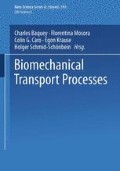Abstract
The arterial wall has constituents which behave as mechano-receptors. It is known, for example, that smooth muscle cells proliferate under the action of applied oscillating stress. There are regions of arterial flow which may be associated with fluctuating wall stresses of elevated magnitude and frequency. These regions are located where there is reversed flow and where the diameter is such that the non-dimensional frequency of the pulse wave lies in the transition region between low and high values, (α = r ω/ν; 2 ≤ α ≤ 8). It is thus possible that this is one of the fluid mechanical contributory factors in the development of atherosclerosis and eventual blockage of an artery.
The main concern is with the formation and development of a ring vortex in sinusoidally oscillating flow. It is found that the principal parameter is the product of peak Reynolds number and the taper semi-angle θ; the Reynolds number is based on the maximum reversed flow rate and the diameter at the smaller end of the conical tube. At low to moderate values of the frequency parameter the minimum critical value of Reθ for vortex formation was found to be 10. Velocity and wall shear stress determined from numerical analysis were found to execute an oscillation at ten times the fundamental frequency as separation of the flow approached and as the vortex passed down the tube.
The superficial femoral artery has two bifurcations at the distal end and the possibility of a bend at the knee. Models with bends and bifurcations added showed only a slight reduction of the critical value of Reθ. The value of this parameter in the normal femoral artery is about 1.0. Reduction of Reθ towards this value was observed when there was a stenosis in the cylindrical tube at its junction with the narrow end of the tapered tube.
The present evidence shows that it is only marginally possible that a vortex produced by a stenosis as severe as 50% diameter will result in the persistence of the vortex a relatively short distance up the artery. Measurements were made with a sinusoidally oscillating flow. The nonlinearity observed makes necessary the observation of flow with an arterial waveform. The effect of flexing of the thigh muscles in exercise has not been considered.
Access this chapter
Tax calculation will be finalised at checkout
Purchases are for personal use only
Preview
Unable to display preview. Download preview PDF.
References
Eagles P.M., 1982, Steady flow in locally exponential tubes. Proc. Roy. Soc. Ser. A, 383: 231–145.
Gerrard J.H., 1971, The stability of unsteady axisymmetric incompressible pipe flow close to a piston: I Numerical analysis. J. Fluid Mech. 50: 625–644.
Sir James Lighthill 1978. Waves in fluids. C.U. Press.
Schneck D.J., 1977, Pulsatile flow in a channel of small exponential divergence: III Unsteady flow separation. ASME Ser.J. J. Fluids Eng 99: 333–338.
Womersley J.R., 1955, Oscillatory motion of a viscous liquid in a thin walled elastic tube: I The linear approximation approximation for long waves, Phil. Mag. 46: 199–221.
Author information
Authors and Affiliations
Editor information
Editors and Affiliations
Rights and permissions
Copyright information
© 1990 Springer Science+Business Media New York
About this chapter
Cite this chapter
Gerrard, J.H. (1990). Experiments and Numerical Analysis Relating to Atherogenesis. In: Mosora, F., Caro, C.G., Krause, E., Schmid-Schönbein, H., Baquey, C., Pelissier, R. (eds) Biomechanical Transport Processes. NATO ASI Series, vol 193. Springer, Boston, MA. https://doi.org/10.1007/978-1-4757-1511-8_35
Download citation
DOI: https://doi.org/10.1007/978-1-4757-1511-8_35
Publisher Name: Springer, Boston, MA
Print ISBN: 978-1-4757-1513-2
Online ISBN: 978-1-4757-1511-8
eBook Packages: Springer Book Archive

